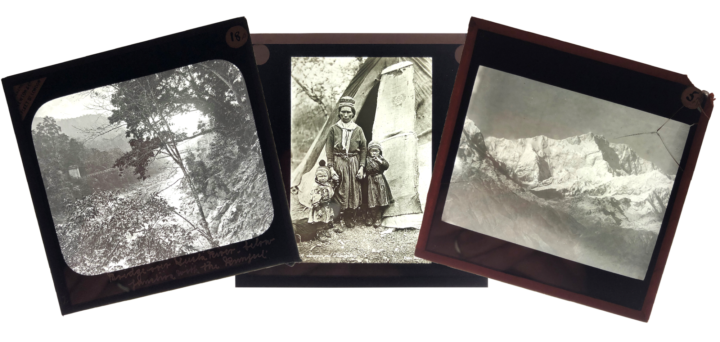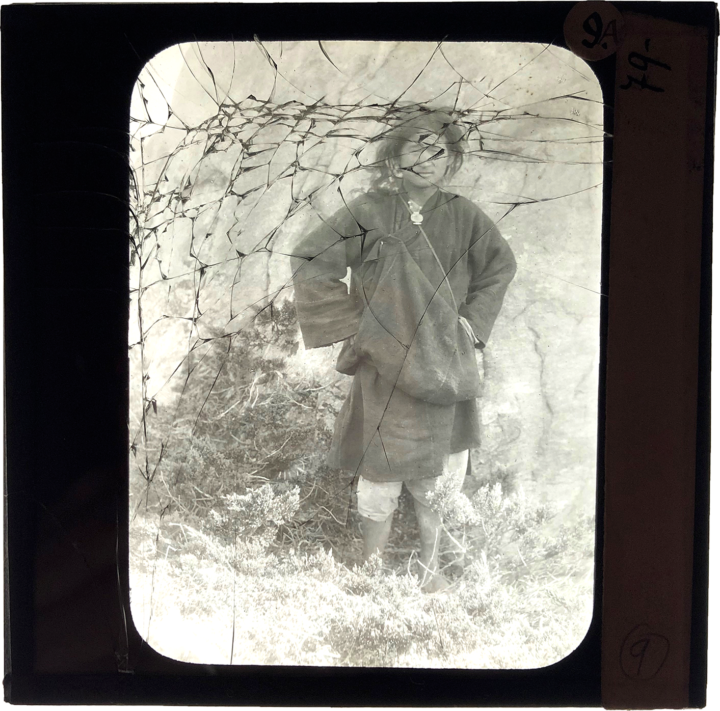To Make Strange Things Appear: Lantern Slides at the Linnean Society
Join Conservator Janet Ashdown as she looks at one of the more obscure collections at the Society
Published on 29th April 2021
The Linnean Society has a small collection of approximately 500 glass magic lantern slides dating from the early 1900s. They appear to have been used for lectures and it is probable that, with some research, they can be accurately dated and connected with particular events and meetings.
Plates, lenses and a light source

Children watching a magic lantern show. Coloured lithograph. Wellcome Collection. Attribution 4.0 International (CC BY 4.0)
Magic lanterns (or laterna magica) were developed in the 17th century, possibly by a Dutch astronomer and physicist named Christiaan Huygens (1629–1695), though much more primitive, and less effective, versions did exist prior to this. A magic lantern was an apparatus used as a way to project images using transparent plates, lenses and a light source—essentially the precursor to the slide projector of the 20th century. These images could be paintings, prints or photographs. (Even diarist Samuel Pepys purchased one, writing: ‘Comes by agreement Mr Reeves, bringing me a lanthorn, with pictures on glass, to make strange things appear on a wall, very pretty.’) Early magic lanterns were lit by candlelight, so images were weaker and audiences were small, but as new light sources like limelight were developed, audiences grew in their thousands.
Initially, these lanterns and slides were mainly used for the purpose of entertainment, but by the 19th century they had been put to educational use. Lighting from kerosene lamps, though not as strong as limelight, meant that magic lanterns could more safely be used in schools, churches and smaller rooms for lecturing. Glass lantern slides were still commonly used until the 1960s when they were gradually replaced by the more popular and convenient 35mm photographic slide. Their continued use was testament to the very high quality and detail of the images, and were still being commercially produced in the 1970s.
Our ‘lecture collection’
The Linnean Society’s collection of glass slides are currently stored in ten boxes—eight wooden, and two cardboard—the earliest dated as being from 1901. The photographic images are mainly black and white, though there are a few in colour. The subjects include photographs of people, locations, plants, birds, insects and animals. There are also many maps, drawings and diagrams.

The Society's lantern slides are kept in wooden boxes, equipped with slots to hold them in place. © The Linnean Society of London
The exact provenance of the majority of these slides is presently unknown, but they clearly relate to events at the Society, and were probably either donated by the speaker, or simply left behind after a talk. Some are even labelled with both the date and the speaker’s name, so in several cases it should be possible to connect them with specific meetings.
The Society’s slides consist of a photographic emulsion, sandwiched between two layers of glass and usually sealed with tape around the edges. This makes them easier to handle than other glass plate positives and negatives, where the emulsion is exposed on one side.

The Society's lantern slides stem from talks given in the early 1900s, covering images of people, landscapes, animals, specimens, maps and diagrams. © The Linnean Society of London
Conserving the magic

Some of the slides show signs of damage, as they are now fragile. It is hoped that funding can be obtained to clean, digitise and rehouse the collection. © The Linnean Society of London
The slides themselves are obviously quite fragile, and the bespoke wooden storage boxes contain slots to keep the slides upright and secure. However, the boxes are heavy to carry and prone to warping, which can result in the brittle and inflexible glass slides cracking. Careless re-packing of the boxes after use also causes damage to the slides. Additionally, in some instances the sealing tape has dried out and separated from the slide edges, leaving them prone to chipping and further damage, and presenting a hazard to anyone handling them.
Currently, a survey of the slides and boxes is underway to provide a better understanding of what images are in the collection, and what measures need to be taken to improve their condition and storage. Our hope is to apply for funding to clean, rehouse and digitise the collection—many of the images would be ‘new’ to our digital assets and would be of use in the future.
Janet Ashdown, Conservator
Reference
